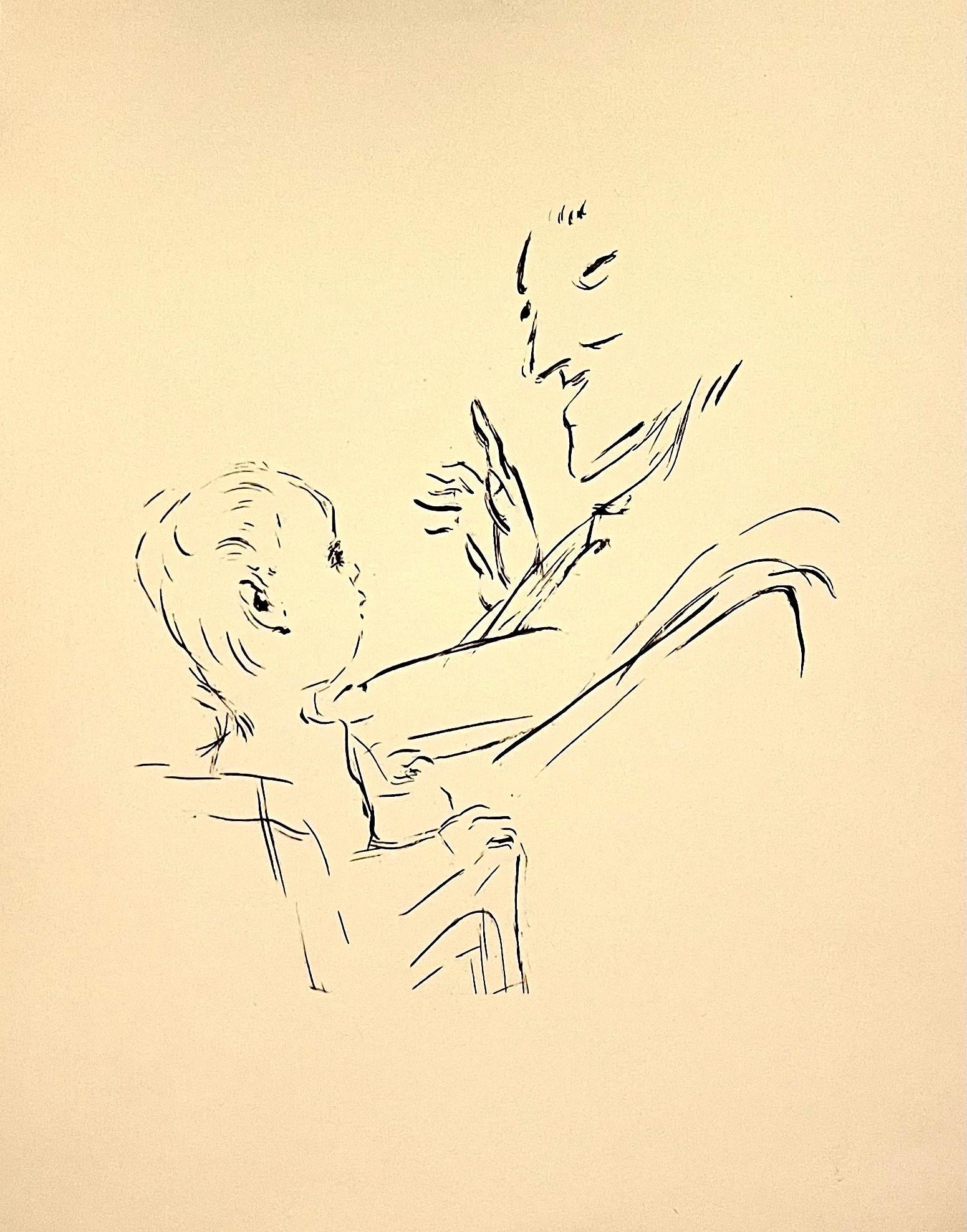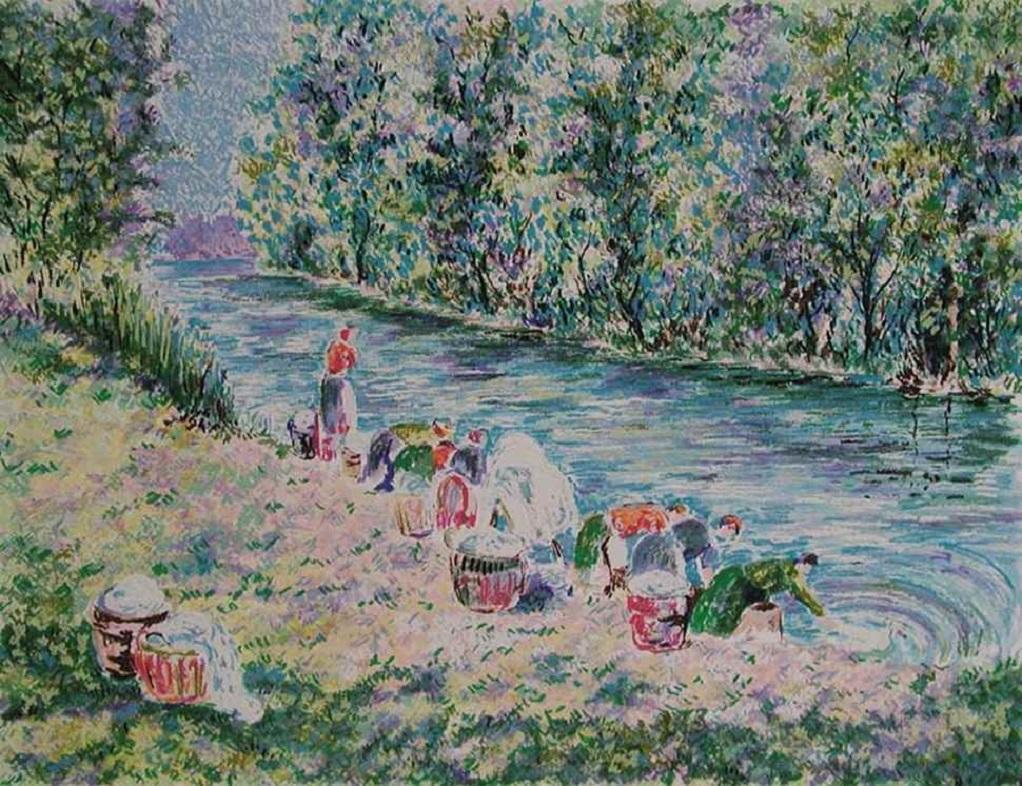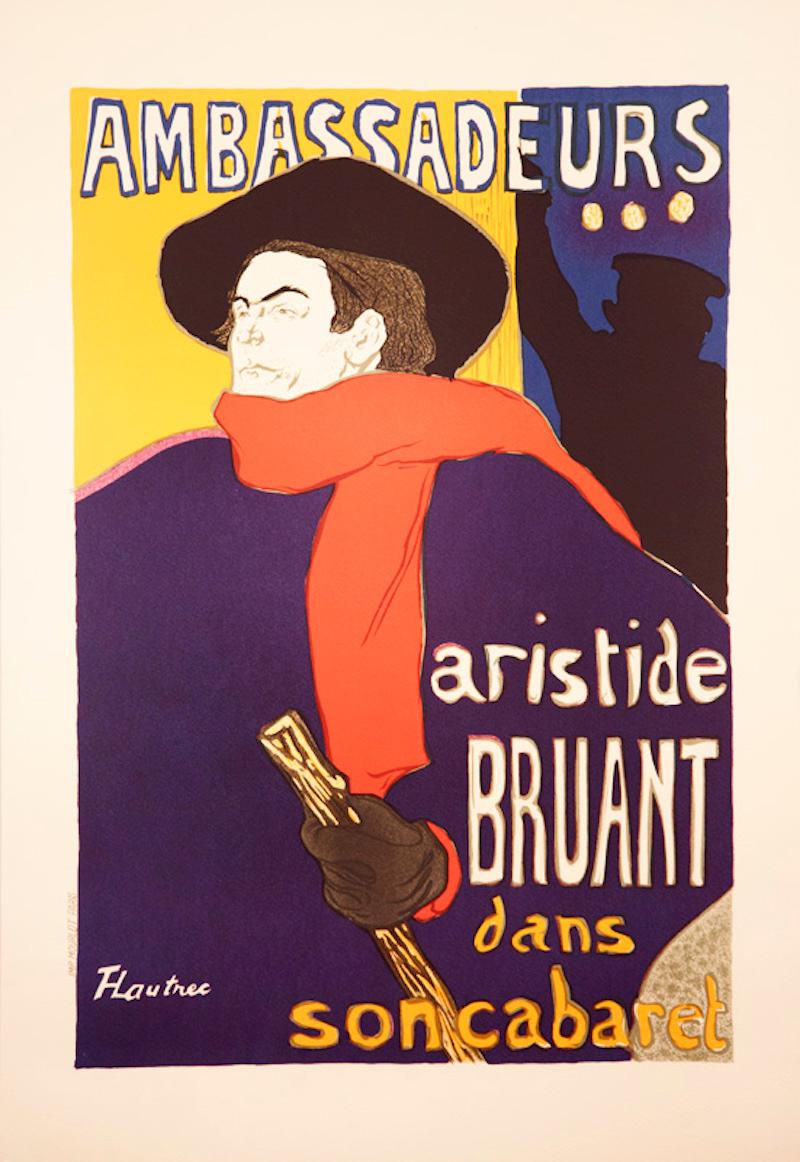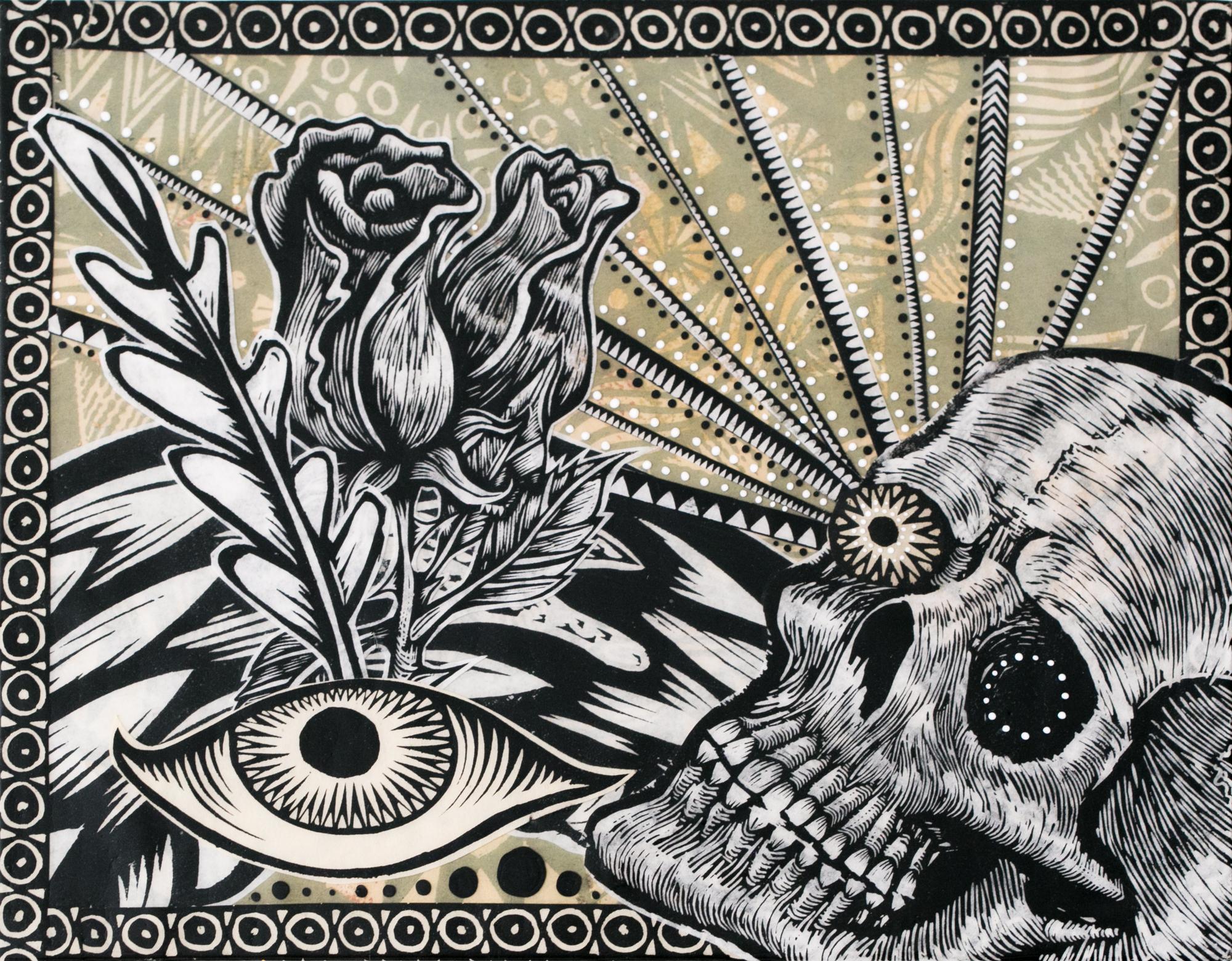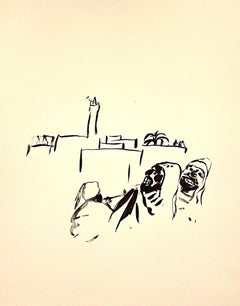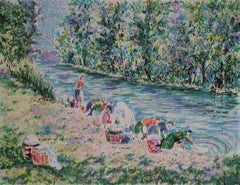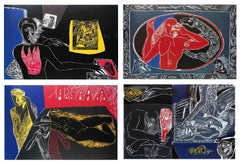
Ulysses - Set of 4 woodcuts
View Similar Items
1 of 6
Mimmo PaladinoUlysses - Set of 4 woodcuts1984
1984
About the Item
- Creator:Mimmo Paladino (1948, Italian)
- Creation Year:1984
- Dimensions:Height: 38.25 in (97.16 cm)Width: 53.13 in (134.96 cm)
- Medium:
- Movement & Style:
- Period:
- Condition:
- Gallery Location:Santa Fe, NM
- Reference Number:1stDibs: LU65832550123
You May Also Like
- Pierre Bonnard Ltd Ed Lithograph Printed at Mourlot Paris 1958 Father and SonBy Pierre BonnardLocated in Surfside, FLThis is from a limited edition portfolio of original lithographs print Fernand Mourlot in Paris in 1958 from work done in collaboration with Bonnard which began in 1928. This is from the rare first edition, No. VII of 20 unbound sets, specially printed for Hans P. Kraus, with Henry de Montherlant inscription to him signed and dated March 3, 1960 These are not individually hand signed or numbered. On BFK Rives French velin art paper Pierre Bonnard (1867 – 1947) was a French painter, illustrator and printmaker, known especially for the stylized decorative qualities of his paintings and his bold use of color. A founding member of the Post-Impressionist group of avant-garde painters Les Nabis, (the Naive artists) his early work was strongly influenced by the work of Paul Gauguin, as well as the prints of Hokusai and other Japanese artists. Bonnard was a leading figure in the transition from Impressionism to Modernism. He painted landscapes, urban scenes, portraits and intimate domestic scenes, where the backgrounds, colors and painting style usually took precedence over the subject. Pierre Bonnard was born in Fontenay-aux-Roses, Hauts-de-Seine on 3 October 1867. His mother, Élisabeth Metzdorff, was from Alsace. His father, Eugène Bonnard, was from the Dauphiné, and was a senior official in the French Ministry of War. He had a brother, Charles, and a sister, Andrée, who in 1890 married the composer Claude Terrasse. He received his education in the Lycée Louis-le-Grand and Lycée Charlemagne in Vanves. He showed a talent for drawing and water colors, as well as caricatures. He painted frequently in the gardens of his parent's country home at Grand-Lemps near the Cote Saint-André in the Dauphiné. He also showed a strong interest in literature. He received his baccalaureate in the classics, and, to satisfy his father, between 1886 and 1887 earned his license in law, and began practicing as a lawyer beginning in 1888. While he was studying law, he also attended art classes at the Académie Julian in Paris. At the Académie Julien he met his future friends and fellow artists, Paul Sérusier, Maurice Denis, Gabriel Ibels and Paul Ranson. In 1888 Bonnard was accepted by the École des Beaux-Arts, where he met Édouard Vuillard and Ker Xavier Roussel. He also sold his first commercial work of art, a design for poster for France-Champagne, which helped him convince his family that he could make a living as an artist. He set up his first studio at on rue Lechapelais and began his career as an artist. From 1893 until her death, Bonnard lived with Marthe de Méligny (1869–1942), and she was the model for many of his paintings, including many nude works. Her birth name was Maria Boursin, but she had changed it before she met Bonnard. They married in 1925. In the years before their marriage, Bonnard had love affairs with two other women, who also served as models for some of his paintings, Renée Monchaty (the partner of the American painter Harry Lachmann) and Lucienne Dupuy de Frenelle, the wife of a doctor; it has been suggested that Bonnard may have been the father of Lucienne's second son. Renée Monchaty committed suicide shortly after Bonnard and de Méligny married. In 1891 he met Toulouse-Lautrec and in December 1891 showed his work at the annual exhibition of the Société des Artistes Indépendants. In the same year Bonnard also began an association with La Revue Blanche, for which he and Edouard Vuillard designed frontispiece In March 1891, his work was displayed with the work of the other Nabis at the Le Barc de Boutteville. The style of Japanese graphic arts became an important influence on Bonnard. In 1893 a major exposition of works of Utamaro and Hiroshige was held at the Durand-Rouel Gallery, and the Japanese influence, particularly the use of multiple points of view, and the use of bold geometric patterns in clothing, such as checkered blouses, began to appear in his work. Because of his passion for Japanese art, his nickname among the Nabis became Le Nabi le trés japonard. He devoted an increasing amount of attention to decorative art, designing furniture, fabrics, fans and other objects. He continued to design posters for France-Champagne, which gained him an audience outside the art world. In 1892 he began to produce lithographs, and painted two of his early notable works, Le Corsage a carreaux and La Partie de croquet. He also made a series of illustrations for the music books of his brother-in-law, Claude Terrasse. In 1895 he became an early participant of the movement of Art Nouveau, designing a stained glass window, called Maternity, for Tiffany. In 1895 he had his first individual exposition of paintings, posters and lithographs at the Durand-Ruel Gallery. He also illustrated a novel, Marie, by Peter Nansen, published in series by in La Revue Blanche. The following year he participated in a group exposition of Nabis at the Ambroise Vollard Gallery. In 1899, he took part in another major exposition of works of the Nabis. Throughout the early 20th century, as artistic styles appeared and disappeared with almost dizzying speed, Bonnard kept refining and revising his personal style, and exploring new subjects and media, but keeping the distinct characteristics of his work. Working in his studio at 65 rue de Douai in Paris, he presented paintings at the Salon des Independents in 1900, and also made 109 lithographs for Parallèment, a book of poems by Verlaine. He also took part in an exhibition with the other Nabis at the Bernheim Jeune gallery. He presented nine paintings at the Salon des Independents in 1901. In 1905 he produced a series of nudes and of portraits, and in 1906 had a personal exposition at the Bernheim-Jeune Gallery. In 1908 he illustrated a book of poetry by Octave Mirbeau, and made his first long stay in the South of France, at the home of the painter Manguin in Saint-Tropez. in 1909, and in 1911 began a series of decorative panels, called Méditerranée, for the Russian art patron Ivan Morozov. During the years of the First World War, Bonnard concentrated on nudes and portraits, and in 1916 completed a series of large compositions, including La Pastorale, Méditterranée, La Paradis Terreste and Paysage de Ville. His reputation in the French art establishment was secure; in 1918 he was selected, along with Renoir, as an honorary President of the Association of Young French Artists. In the 1920s, he produced illustrations for a book by Andre Gide (1924) and another by Claude Anet (1923). He showed works at the Autumn Salon in 1923, and in 1924 was honored with a retrospective of sixty-eight of his works at the Galerie Druet. In 1925 he purchased a villa in Cannes. In 1938 his works and Vuillard were featured at an exposition at the Art Institute of Chicago. The outbreak of World War II in September 1939, forced Bonnard to depart Paris for the south of France, where he remained until the end of the war. Under the German occupation, he refused to paint an official portrait of the French collaborationist leader, Marechal Petain, but accepted a commission to paint a religious painting of Saint Francis de Sales, with the face of his friend Vuillard, who had died two years earlier. He finished his last painting, The Almond Tree in Blossom, a week before his death in his cottage on La Route de Serra Capoue near Le Cannet, on the French Riviera, in 1947. The Museum of Modern Art in New York City organized a posthumous retrospective of Bonnard's work in 1948, although originally it was meant to be a celebration of the artist's 80th birthday. Bonnard particularly used the model of Japanese art in a series...Category
20th Century Post-Impressionist More Prints
MaterialsLithograph
- Pierre Bonnard Lithograph Printed at Mourlot Paris 1958 Mosque Minaret, VillageBy Pierre BonnardLocated in Surfside, FLThis is from a limited edition portfolio of original lithographs print Fernand Mourlot in Paris in 1958 from work done in collaboration with Bonnard which began in 1928. A walled city with a mosque with a minaret with Arabs standing in the foreground. This is from the rare first edition, No. VII of 20 unbound sets, specially printed for Hans P. Kraus, with Henry de Montherlant inscription to him signed and dated March 3, 1960 These are not individually hand signed or numbered. On BFK Rives French velin art paper Pierre Bonnard (1867 – 1947) was a French painter, illustrator and printmaker, known especially for the stylized decorative qualities of his paintings and his bold use of color. A founding member of the Post-Impressionist group of avant-garde painters Les Nabis, (the Naive artists) his early work was strongly influenced by the work of Paul Gauguin, as well as the prints of Hokusai and other Japanese artists. Bonnard was a leading figure in the transition from Impressionism to Modernism. He painted landscapes, urban scenes, portraits and intimate domestic scenes, where the backgrounds, colors and painting style usually took precedence over the subject. Pierre Bonnard was born in Fontenay-aux-Roses, Hauts-de-Seine on 3 October 1867. His mother, Élisabeth Metzdorff, was from Alsace. His father, Eugène Bonnard, was from the Dauphiné, and was a senior official in the French Ministry of War. He had a brother, Charles, and a sister, Andrée, who in 1890 married the composer Claude Terrasse. He received his education in the Lycée Louis-le-Grand and Lycée Charlemagne in Vanves. He showed a talent for drawing and water colors, as well as caricatures. He painted frequently in the gardens of his parent's country home at Grand-Lemps near the Cote Saint-André in the Dauphiné. He also showed a strong interest in literature. He received his baccalaureate in the classics, and, to satisfy his father, between 1886 and 1887 earned his license in law, and began practicing as a lawyer beginning in 1888. While he was studying law, he also attended art classes at the Académie Julian in Paris. At the Académie Julien he met his future friends and fellow artists, Paul Sérusier, Maurice Denis, Gabriel Ibels and Paul Ranson. In 1888 Bonnard was accepted by the École des Beaux-Arts, where he met Édouard Vuillard and Ker Xavier Roussel. He also sold his first commercial work of art, a design for poster for France-Champagne, which helped him convince his family that he could make a living as an artist. He set up his first studio at on rue Lechapelais and began his career as an artist. From 1893 until her death, Bonnard lived with Marthe de Méligny (1869–1942), and she was the model for many of his paintings, including many nude works. Her birth name was Maria Boursin, but she had changed it before she met Bonnard. They married in 1925. In the years before their marriage, Bonnard had love affairs with two other women, who also served as models for some of his paintings, Renée Monchaty (the partner of the American painter Harry Lachmann) and Lucienne Dupuy de Frenelle, the wife of a doctor; it has been suggested that Bonnard may have been the father of Lucienne's second son. Renée Monchaty committed suicide shortly after Bonnard and de Méligny married. In 1891 he met Toulouse-Lautrec and in December 1891 showed his work at the annual exhibition of the Société des Artistes Indépendants. In the same year Bonnard also began an association with La Revue Blanche, for which he and Edouard Vuillard designed frontispiece In March 1891, his work was displayed with the work of the other Nabis at the Le Barc de Boutteville. The style of Japanese graphic arts became an important influence on Bonnard. In 1893 a major exposition of works of Utamaro and Hiroshige was held at the Durand-Rouel Gallery, and the Japanese influence, particularly the use of multiple points of view, and the use of bold geometric patterns in clothing, such as checkered blouses, began to appear in his work. Because of his passion for Japanese art, his nickname among the Nabis became Le Nabi le trés japonard. He devoted an increasing amount of attention to decorative art, designing furniture, fabrics, fans and other objects. He continued to design posters for France-Champagne, which gained him an audience outside the art world. In 1892 he began to produce lithographs, and painted two of his early notable works, Le Corsage a carreaux and La Partie de croquet. He also made a series of illustrations for the music books of his brother-in-law, Claude Terrasse. In 1895 he became an early participant of the movement of Art Nouveau, designing a stained glass window, called Maternity, for Tiffany. In 1895 he had his first individual exposition of paintings, posters and lithographs at the Durand-Ruel Gallery. He also illustrated a novel, Marie, by Peter Nansen, published in series by in La Revue Blanche. The following year he participated in a group exposition of Nabis at the Ambroise Vollard Gallery. In 1899, he took part in another major exposition of works of the Nabis. Throughout the early 20th century, as artistic styles appeared and disappeared with almost dizzying speed, Bonnard kept refining and revising his personal style, and exploring new subjects and media, but keeping the distinct characteristics of his work. Working in his studio at 65 rue de Douai in Paris, he presented paintings at the Salon des Independents in 1900, and also made 109 lithographs for Parallèment, a book of poems by Verlaine. He also took part in an exhibition with the other Nabis at the Bernheim Jeune gallery. He presented nine paintings at the Salon des Independents in 1901. In 1905 he produced a series of nudes and of portraits, and in 1906 had a personal exposition at the Bernheim-Jeune Gallery. In 1908 he illustrated a book of poetry by Octave Mirbeau, and made his first long stay in the South of France, at the home of the painter Manguin in Saint-Tropez. in 1909, and in 1911 began a series of decorative panels, called Méditerranée, for the Russian art patron Ivan Morozov. During the years of the First World War, Bonnard concentrated on nudes and portraits, and in 1916 completed a series of large compositions, including La Pastorale, Méditterranée, La Paradis Terreste and Paysage de Ville. His reputation in the French art establishment was secure; in 1918 he was selected, along with Renoir, as an honorary President of the Association of Young French Artists. In the 1920s, he produced illustrations for a book by Andre Gide (1924) and another by Claude Anet (1923). He showed works at the Autumn Salon in 1923, and in 1924 was honored with a retrospective of sixty-eight of his works at the Galerie Druet. In 1925 he purchased a villa in Cannes. In 1938 his works and Vuillard were featured at an exposition at the Art Institute of Chicago. The outbreak of World War II in September 1939, forced Bonnard to depart Paris for the south of France, where he remained until the end of the war. Under the German occupation, he refused to paint an official portrait of the French collaborationist leader, Marechal Petain, but accepted a commission to paint a religious painting of Saint Francis de Sales...Category
20th Century Post-Impressionist More Prints
MaterialsLithograph
- Series - Les Lavandières by Lélia Pissarro - ScreenprintBy Lelia PissarroLocated in London, GBSOLD UNFRAMED Series - Les Lavandières by Lélia Pissarro (B. 1963) Serigraph 38 x 48 cm (15 x 18 ⁷/₈ inches) Signed and numbered Printed in an edition of 300 Artist's Biography: B...Category
21st Century and Contemporary Post-Impressionist More Prints
MaterialsScreen
$354 Sale Price20% Off - Ambassadeurs Aristide Bruant in his cabaret by Henri de Toulouse-LautrecBy (After) Henri Toulouse LautrecLocated in New York, NYThis lithographic poster illustrates Aristide Bruant who was a famous performer and cabaret owner in Paris at the turn of the 20th century. Lautrec, seizing on Bruant's trademark cos...Category
Late 19th Century Post-Impressionist Figurative Prints
MaterialsLithograph
- Untitled, Jim DineBy Jim DineLocated in New York, NYA familiar and iconic motif by the artist, this color woodcut was created by Jim Dine in 1996, is hand-signed in pencil and numbered. Measuring 26 1/8 x 19 ½ inches (66.4 x 49.5 cm...Category
20th Century Contemporary Figurative Prints
MaterialsWoodcut
Price Upon Request - Adorable Tim Engelland Farmhouse Pig WoodcutLocated in Larchmont, NYTim Engelland (American, 1950-2012) Untitled, 1996 Woodcut 7 1/2 x 8 1/2 in. Signed and dated lower right: T. Engelland, 1996 Numbered lower left: 102/200 A lifelong artist, Engelland specialized in oil portraits and landscapes, and also worked extensively in woodcuts and linocuts. He was born on Jan. 5, 1950, in Ames, Iowa, the son of Charles Wilbur “Will” Engelland and Patricia Fairman Engelland.. Tim grew up in Terre Haute, IN, attending Fairbanks Elementary School and Indiana State University’s Laboratory School. He knew he wanted to be an artist from an early age, and was mentored by Lab School’s John Laska, graduating in 1968. He received a BFA from Temple University’s Tyler School of Art; was a Norfolk Fellow at Yale University; and received his MFA from Cornell University, teaching there for two years after graduation. He spent the majority of his career, from 1976-2004, at Deerfield Academy, a prestigious preparatory school in Deerfield, Mass. There he taught art and photography, coached basketball and lacrosse, and served as faculty resident. When the school began accepting female students, Tim designed The Deerfield Girl, a bronze statue to accompany The Deerfield Boy statue...Category
1990s Contemporary More Prints
MaterialsWoodcut
